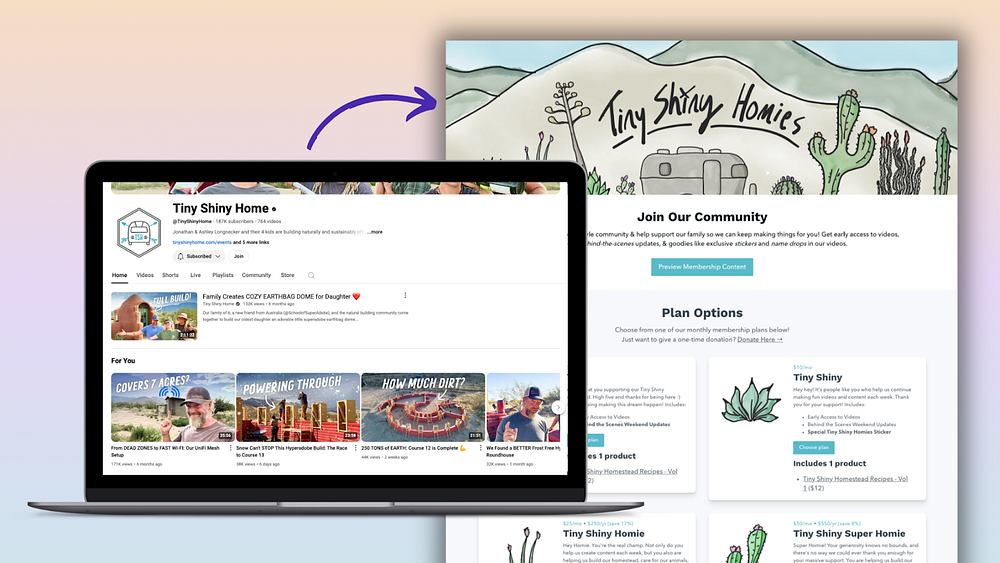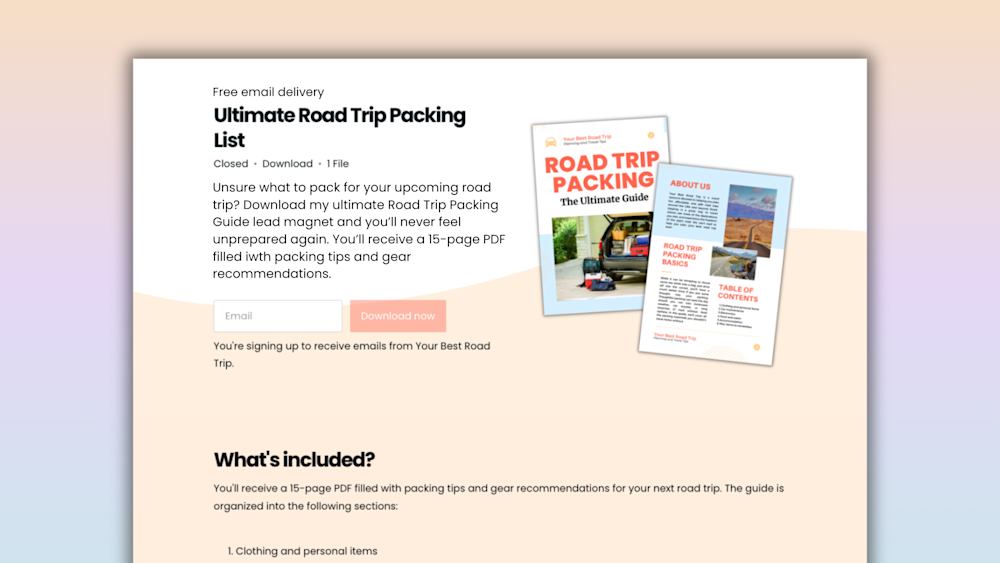You’ve just spent 15+ hours scripting, shooting, and editing another video to your YouTube channel.
This one needs to get more views, or else it’s never going to generate the leads and sales you need to justify the nearly two full workdays that went into it.
Take heart -- getting those views, plus the sales that come with them, is exactly what we’re going to help with today with our six video marketing strategies that anyone can use.
Each of them is easy enough for a video marketing newbie, but tried-and-tested enough for even big brands to capitalize on.
Let’s jump right in.
6 video marketing strategies for solopreneurs
#1: Share your video content beyond YouTube
The first video marketing strategy is to diversify your social platforms beyond YouTube.
Sure, YouTube is a great place to share your videos, but it’s just one pillar in your overall video marketing strategy, and pillars need support.
There are plenty of other platforms where you can share videos to extend your reach and increase sales. And if you’re specifically using social media to sell more products, you’re doing your bottom line a disservice by not branching out.
For instance, Instagram is worth checking out if you want a platform that offers multiple video formats. Instagram lets you post four main types of video, which are:
-
Video posts that are 60 seconds or less
-
Stories that are 15 seconds or less
-
Instagram TV (IGTV) videos with a maximum run time of 15 to 60 minutes, depending on how you upload them
-
Instagram Live which, like the name implies, are live streams
If you’re new to Instagram, Stories is an easy format to get started with.
It’s a popular one, too: over 500 million accounts use Stories each day. Plus, they’re easier to produce than other Instagram video types since the max length is 15 seconds.
As far as video content, you can use Stories to teach an excerpt from one of your online course lessons, share a fact or tip of the day, or ask your followers a question as a way to conduct customer research.
Besides Instagram, you could use its sister platform, Facebook.
At nearly 2.6 billion monthly active users, Facebook video formats are ideal for reaching a broad audience.
Just publish recorded videos on Facebook or use Facebook Live to live-stream content to your audience.
If you’re looking for someone living out this strategy, check out Mari Smith, a Facebook marketing expert. She frequently posts educational videos to her Facebook page.
Are her views viral? No. But they’re highly engaged, and engagement outweighs views any day.
Besides Instagram and Facebook, another option is to create or repurpose videos on Pinterest in the form of video pins, such as this video pin from Cara Chace.
This is the idea of it:
If you have video content already, you have the ability to reach bigger audiences by moving beyond YouTube. Instagram and Facebook are the two most natural choices, but don’t count out platforms like Pinterest or TikTok, either.
Experiment and try expanding your audience by repurposing your already great video content for different channels.
That said, experimentation isn’t just for the platforms you post to -- you should do it with the types of things you post, too. Let me explain in the next tip.
#2. Try out multiple formats for your videos
We all have a format we love for content. It’s tried, it’s true, and it’s comfortable.
It also stands a good chance of growing stagnant.
And stagnation is a guaranteed way to keep your viewership from growing. Break out of the comfortable every once in a while and try a new format on for size.
It might resonate a lot better than you’re expecting.
For example, how-to videos, tutorials, and hack videos are popular with 46% of millennials and Gen Zers, which make them fantastic options for getting would-be customers to trust you and enter your sales funnel.
This is what 60 Second Docs taps into when creating educational documentaries about a host of topics -- such as this video about embroidering cat portraits -- that are each 60 seconds long.
Likewise, Kroger shared this video about setting up a food spread for Super Bowl Sunday.
Kroger’s video focuses on the foods viewers can prepare for the occasion. Rather than explicitly mentioning their products in the video, they saved the details for the post caption, which helps the brand avoid the too-salesy route.
That’s not to say you can’t include sales info in your video content. If you plan on using your videos to promote your business and products explicitly, just tinker with the story your video tells, so it’s not a direct sales pitch.
Take, for example, Blendtec, which created its “Will it Blend?” series on YouTube.
Blendtec blended a variety of everyday objects in their blender, which, on the surface, entertains viewers. Yet the videos also serve as product demonstration videos for the Blendtec blender.
No one is mistaking Blendtec’s angle -- they’re definitely trying to sell their product -- but because it’s dressed up in entertaining, high-quality content, it comes off as less of a direct promotion and more of a subtle aside.
And with each of the above videos coming in at under four minutes and at over 190,000 views, it’s clearly working.
Here’s what it boils down to:
Whether you’re trying to make money on YouTube by selling info products or blenders, people don’t love sitting through promotions. With rare exceptions -- think SuperBowl ads -- most viewers won’t give you the time of day without value or entertainment to carry them through.
So if you’re in the market to sell something, and you’re trying to do it on YouTube, get creative with your format, and don’t be afraid to try formats you’ve never seen before.
Just make sure that, regardless of the format you use or even the platform you’re posting to, you keep it short and to the point.
It’s what people want.
#3. Create short videos with informative openers
Long videos have their place in your video marketing strategy, but as a general rule, you should create shorter videos that are packed with information rather than long ones.
Why?
Short videos are the trend these days. In fact, the average video was just 4.07 minutes in 2018, with 73% of videos being under two minutes.
These brief lengths don’t give you much real estate for spreading your message and wooing viewers, though.
One way around this hurdle is to be more concise with your content, so you can convert customers even if they only watch your video for a short stint.
The most important factor here is to include a compelling and informative opening, which you can do by posing a question to your audience that immediately piques their curiosity. In other words, hook your audience in your video’s opening.
This is the approach creators Kara and Nate take in the opening of this video about what they’d do after reaching their goal of visiting 100 countries.
In their opener, Nate shares that he doesn’t know what their next steps are, which entices viewers to continue watching to learn more about the options Kara and Nate consider.
Also, just like Clark Kegley does in his video about journaling for beginners, another option is to use your opener to summarize what your video will cover and what viewers will learn from it. Use it as a tease.
If you’re more of the bold type and want to spice things to really grab your viewers’ interest, don’t say anything at all -- just use visuals to inform viewers of what’s to come.
For instance, Insider opens their video about Iceland’s Blue Lagoon beauty products with footage of someone applying a mud mask -- no words needed.
After grabbing viewers with your opening, quickly introduce your points so viewers can get answers to their questions as fast as possible.
Basically, whether you’re creating educational videos or entertaining videos, opt for a steady flow of short and interesting video content over long videos that aren’t punchy.
On the topic of keeping a steady flow, don’t forget to publish videos consistently.
#4. Post consistently and keep your brand consistent
If you don’t want your content to be buried, post regularly, so people have more chances to get hooked on your content.
After all, there’s a ton of content to compete with. So much so that over 500 hours of video are uploaded to YouTube each minute.
To stand out from the ginormous crowd, become a reliable resource for your audience by creating and publishing consistently.
Make your reliable publishing schedule known, too. You can explicitly state how often and when you post, as Ally Bakes does in her YouTube channel header.
It goes without saying that you should mean what you say. So, if someone glances at your upload history, it should reflect the cadence that you announce on your channel header.
For instance, by perusing Learn French with Alexa’s YouTube channel, you can easily tell that she posts around three times per week.
If coming up with fresh video content to post regularly sounds like a struggle to you, consider repurposing your non-video content (like blog articles and infographics) and converting them into videos.
Start with more popular pieces of content to up your chances of creating video content that resonates with your viewership. This will save you from having to go back to the drawing board to come up with new content ideas.
For another content idea, though, try adding user-generated content (UGC) videos to your channel. Given that 79% of people claim UGC significantly influences their buying decisions, it’s a wise move.
While we’re on the topic of influencing buying decisions, it’s important to keep your branding consistent as well. Consistency is one of the most important branding tips for entrepreneurs, and here’s why.
Keeping a unified appearance, including your color scheme and fonts, helps viewers identify and choose your video over others that appear on the results page.
Many of Tasha Leelyn’s thumbnails, for example, include a pink and gold color scheme, a bubble or cursive font, and an overall vibrant vibe.
This adds to the cohesion of her channel, as well as makes her more visually memorable for her loyal viewers.
All in all, posting regularly and keeping your branding consistent across videos are perhaps the simplest video marketing strategies for small businesses.
Being consistent doesn’t just apply to your publishing calendar and branding, though. It’s also vital to consistently provide value to your audience and offer a CTA -- which neatly brings us to our next tip for getting more bang for your marketing buck with videos.
#5. Always provide value and a call to action
To earn your audience’s trust, and dollars, it’s key to provide your viewers with a regular stream of informative, useful, and actionable videos.
Each video you release is an opportunity to earn a potential customer’s trust and guide them into your sales funnel by taking an action.
For instance, after you’ve earned your audience’s interest, you can encourage them to watch another video, subscribe to your channel, join your email list, or purchase a product.
But to get viewers to take action, you’ll need to include an explicit CTA.
Check out how I Like to Make Stuff includes clickable end-screen elements at the end of this video about making a treehouse, which encourages viewers to watch two other videos and subscribe to their two YouTube channels.
Their CTA makes it easy for viewers to know what they should do next, and the clickable video elements make it a painless process.
Or, in another example, Home Organizing by Alejandra.tv includes a link to a landing page that features a product she wants her viewers to check out.
You can follow in the footsteps of Alejandra’s and I Like to Make Stuff’s channels and include an explicit CTA at the end of your video, so your audience knows exactly what to do next.
If you’re worried about coming across as pushy or salesy by including a CTA in your video (provided your video was 90% or more non-sales content), don’t be.
People don’t mind CTAs. In fact, 45% of adults believe videos with a CTA are helpful.
Plus, 53% of adults engage with a business after watching a video on social media, whether it’s visiting their website or conducting further research, so it’s an easy win-win for a business to combine CTAs with their videos.
Optimizing your videos for each search engine or platform -- our last tip -- also helps you attract and convert more viewers, maximizing your returns further.
#6. Follow YouTube SEO and video SEO best practices
Our final tip today is to incorporate SEO into your video marketing.
I get it: SEO can be intimidating (though, hopefully, these simple SEO tips can make it less scary).
But, if you optimize your videos, search engines like Google and YouTube will be more likely to recommend them.
After all, Google has a section of its results page just for video results, as you can see in the example below.
And YouTube is, at the end of the day, a visual search engine.
According to Alexa, YouTube is the second most popular website in the world and gets nearly 16% of its traffic from search engines, which makes optimizing your YouTube video page hugely important for YouTube to recommend your videos to searchers.
Besides, an impressive 81% of people say they at least sometimes watch videos recommended by YouTube, so earning that recommendation is worth the effort.
For those reasons and more, it’s worth stepping up your video SEO and YouTube SEO game to see more ROI from your video marketing efforts.
To start, find the keywords you want to target. Use YouTube SEO tools, like TubeBuddy or Keyword Tool, to find keywords to feature on your video’s page.
Then, include your target keyword -- or a partial match for it -- in your title.
Don’t sweat it if you can’t fit your target keyword in fully. Only 38% to 45% of videos rank with an exact match keyword.
And while using an exact match keyword can help you rank higher in the search results, it doesn’t guarantee a higher position.
On top of including a keyword in your title, try to keep it short. One study found that videos in the top 20 search results had between 47 to 48 characters, on average.
Don’t shy away from using keywords in your YouTube video description, either.
Another study found a positive relationship between using a broad match keyword (or partial keyword) in descriptions and a video’s ranking.
Additionally, make sure to keep your descriptions focused, informative, and short. Descriptions between 300 to 350 words performed best, according to a recent study.
Finally, don’t forget to include keywords in your YouTube video tags. The same study above found that there was a positive relationship between using keywords in tags and video ranking.
It sounds like a lot, I know. It definitely can be a lot, especially in the beginning when you’re still learning.
But trust me: though it takes some planning and strategy upfront, optimizing your videos for search engines can pay off in spades later on.
Use these 6 video marketing strategies to skyrocket your business
Getting started with video marketing can be difficult, and your first few videos may not be what you were hoping for.
But, by continuing to focus on delivering the highest value possible to your viewers, your skills -- and confidence -- will develop over time.
If you want to leverage your video content to boost your brand awareness and sales, use our six beginner-friendly video marketing strategies:
-
#1. Test different social platforms to reach new audiences.
-
#2. Try out different video formats, too, to see what resonates best with your audience.
-
#3. Keep your videos short and packed with interesting, valuable information, and use a compelling hook in your intro.
-
#4. Post regularly and keep your brand consistent across videos to build rapport among your video audience.
-
#5. Fill your videos with as much value as possible, and top it off with an enticing CTA.
-
#6. Use video SEO to optimize your videos for each platform.
Happy creating -- and selling.



